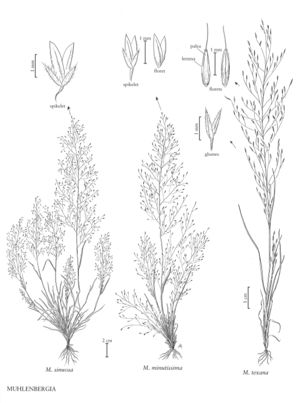Difference between revisions of "Muhlenbergia minutissima"
FNA>Volume Importer |
FNA>Volume Importer |
||
| Line 23: | Line 23: | ||
-->{{Treatment/Body | -->{{Treatment/Body | ||
|distribution=Colo.;N.Mex.;Tex.;Utah;Calif.;Nebr.;S.Dak.;Oreg.;Mont.;Wyo.;Wash.;Ariz.;Idaho;Nev. | |distribution=Colo.;N.Mex.;Tex.;Utah;Calif.;Nebr.;S.Dak.;Oreg.;Mont.;Wyo.;Wash.;Ariz.;Idaho;Nev. | ||
| − | |discussion=<p | + | |discussion=<p>Muhlenbergia minutissima grows in sandy and gravelly drainages, rocky slopes, flats, road cuts, and open sites. It is usually found in yellow pine and oak-pine forests, pinyon-juniper woodlands, thorn-scrub forests, and oak-gramma savannahs, at elevations of 1200-3000 m. Its range extends from the western United States to southern Mexico.</p> |
|tables= | |tables= | ||
|references= | |references= | ||
| Line 39: | Line 39: | ||
|basionyms= | |basionyms= | ||
|family=Poaceae | |family=Poaceae | ||
| + | |illustrator=Linda A. Vorobik and Annaliese Miller | ||
|distribution=Colo.;N.Mex.;Tex.;Utah;Calif.;Nebr.;S.Dak.;Oreg.;Mont.;Wyo.;Wash.;Ariz.;Idaho;Nev. | |distribution=Colo.;N.Mex.;Tex.;Utah;Calif.;Nebr.;S.Dak.;Oreg.;Mont.;Wyo.;Wash.;Ariz.;Idaho;Nev. | ||
|reference=None | |reference=None | ||
| Line 44: | Line 45: | ||
|publication year= | |publication year= | ||
|special status= | |special status= | ||
| − | |source xml=https:// | + | |source xml=https://bibilujan@bitbucket.org/aafc-mbb/fna-data-curation.git/src/314eb390f968962f596ae85f506b4b3db8683b1b/coarse_grained_fna_xml/V25/V25_781.xml |
|subfamily=Poaceae subfam. Chloridoideae | |subfamily=Poaceae subfam. Chloridoideae | ||
|tribe=Poaceae tribe Cynodonteae | |tribe=Poaceae tribe Cynodonteae | ||
Revision as of 16:18, 30 October 2019
Plants annual. Culms 5-40 cm, slender, erect; internodes mostly glabrous, scabridulous or smooth, scabridulous or strigulose below the nodes. Sheaths shorter or longer than the internodes, smooth or scabridulous; ligules 1-2.6 mm, hyaline, truncate to obtuse, sometimes with lateral lobes; blades 0.5-4(10) cm long, 0.8-2 mm wide, flat or involute, scabrous abaxially, shortly pubescent adaxially. Panicles 5-16.2(21) cm long, 1.5-6.5 cm wide, open; primary branches 8-42 mm, often capillary, diverging 25-80° from the rachises; pedicels 2-7 mm, straight or curved, but rarely curved as much as 90°. Spikelets 0.8-1.5 mm. Glumes sparsely strigulose, at least near the apices, 1-veined; lower glumes 0.5-0.8 mm, obtuse to acute; upper glumes 0.6-0.9 mm, broader than the lower glumes, obtuse; lemmas 0.8-1.5 mm, lanceolate, brownish to purplish, glabrous or the midveins and margins appressed-pubescent, apices obtuse to subacute, unawned; paleas 0.8-1.4 mm, shortly pubescent or glabrous; anthers 0.2-0.7 mm, purplish. Caryopses 0.6-0.9 mm, fusiform to elliptic, brownish. 2n = 60, 80.
Distribution
Colo., N.Mex., Tex., Utah, Calif., Nebr., S.Dak., Oreg., Mont., Wyo., Wash., Ariz., Idaho, Nev.
Discussion
Muhlenbergia minutissima grows in sandy and gravelly drainages, rocky slopes, flats, road cuts, and open sites. It is usually found in yellow pine and oak-pine forests, pinyon-juniper woodlands, thorn-scrub forests, and oak-gramma savannahs, at elevations of 1200-3000 m. Its range extends from the western United States to southern Mexico.
Selected References
None.
